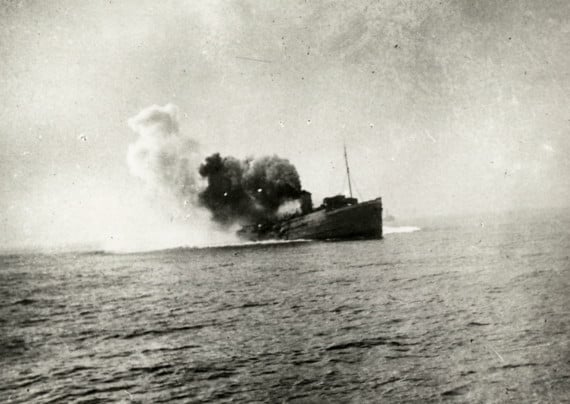In the early morning of May 29, 1940, Isle of Man Steam Packet Company ship Mona’s Queen was approaching Dunkirk for the second time.
The engineers had been taking turns to escape the heat of the boilers. Bob Kneale was on deck when the scene gradually revealed itself through the mist: the beaches were lined with troops and the entire town seemed to be on fire.
'You’ve never seen the likes of it,’ he told his colleague Lacey Knowles, who went up to look for himself. Knowles was on deck when the magnetic mine detonated.
The boilers exploded and tore the ship apart, the explosion echoing across the beaches. Mona’s Queen sank in two minutes: of the 24 men killed, 19 were Manx. Knowles was the only engineer among the 28 survivors.
Eighty years ago today (Friday) a group of Manxmen found themselves in the middle of cataclysmic events that became the stuff of legend.
For Prime Minister Winston Churchill, the rescue of over 330,000 British and French troops from Dunkirk was a ’miracle of deliverance’. But the evacuation was no miracle - it was a human achievement, and a human tragedy.
In the thick of it were nine Steam Packet ships, mostly manned by their peacetime civilian crews. They were sailing for Dunkirk before the evacuation had officially begun on May 26 and were among the last to leave in the early hours of June 4 as the town was finally overrun by German forces.
Roughly one in every 15 troops evacuated from Dunkirk was carried on Manx ships. According to official numbers, they retrieved at least 21,010 British and French troops, but some estimates go as high as 25,000.
In exchange were some irreparable losses - 40 civilian employees of the Steam Packet, 28 of them Manx, were killed on one fateful day.
These untrained civilians were subjected to nine days of bombing, shelling and strafing aboard virtually unarmed ships. In the words of Vice-Admiral Bertram Ramsay, who masterminded the evacuation, they were subjected to a test that was 'beyond the limit of human endurance’.
Among the misconceptions of Dunkirk is the idea that most of the troops were plucked from beaches.
In fact the majority were loaded from a long pier that stretched almost a mile out to sea from the harbour.
For the crews waiting alongside, with the Luftwaffe overhead, it was a terrifying waiting game: 'We were a sitting duck, like an aunt sally at a fairground, not even a machine gun with which to fire back...the ship would be at least three hours taking troops aboard,’ wrote Thomas Cannell, who was aboard the Ben My Chree.
'In the boiler room that night, as the ship lay at Folkestone, I recall thinking to myself: "Surely they can’t send us back into that Hell a second time!" But of course they did, and the next day we were crossing the Channel again to Dunkirk.’
Some Manx stories have passed into legend. When he reached the pier with 50 of his men, Humphrey Bredin of the Royal Ulster Rifles was directed to the Ben My Chree.
Bredin stepped over a body on the gangplank and found himself in a walnut-panelled saloon, where a steward in a white coat was trying not to disturb the exhausted troops who covered most of the floor.
Bredin remembered asking the steward for a glass of beer: 'He said, "Yes sir, by all means. But of course you do know the rules - I can’t supply you with any alcohol until we’re three miles out." I thought to myself, "We can’t lose the war with people like this around!’’’
One particular day, 80 years ago today, is remembered in the Isle of Man. It began with the destruction of Mona’s Queen at 5.30am, but there was more to come.
During the afternoon, King Orry sailed into the teeth of an air raid and was left drifting helplessly, eventually sinking just outside the harbour.
Fenella had 650 troops aboard when the bombers found their target.
One bomb fell between the pier and the ship and exploded on the sea bed, smashing the engine room to pieces and leaving the ship sinking in the shallow water. The troops and the crew escaped onto a paddle steamer called Crested Eagle, which was soon hit by four bombs; when the blazing ship was finally beached, only 200 survivors made it into the water.
Sixteen of Fenella’s crew, at least nine of them Manx, never escaped Crested Eagle. The survivors joined the thousands of ragged troops on the beaches and desperately waited for rescue.
Some of the remaining Manx crews - aboard Manx Maid, Ben My Chree, Manxman, Tynwald and Lady of Mann - witnessed the death of their friends and the destruction of their fellow ships.
Some were still standing at the bitter end on June 4; others were gradually overwhelmed by exhaustion, shock and trauma.
The evacuation - codenamed Operation Dynamo - had been expected to last for two days, with the modest hope of lifting 45,000 troops from the shrinking perimeter around Dunkirk.
Nine days later, 338,226 Allied troops had been carried to England aboard Royal Navy destroyers and 850 ships of all kinds, from troopships and paddle steamers to fishing boats and pleasure cruisers.
Broadcasting on the BBC Home Service on June 5, broadcaster JB Priestley tapped into the national mood of deliverance.
He paid tribute to the Isle of Wight ferry Gracie Fields, but he could just as easily have been talking about Mona’s Queen: 'This little steamer, like all her brave and battered sisters, is immortal. She’ll go sailing proudly down the years in the epic of Dunkirk.
'And our great grandchildren, when they learn how we began this war by snatching glory out of defeat, and then swept on to victory, may also learn how the little holiday steamers made an excursion to hell and came back glorious.’
Memory is a fickle thing; over time Dunkirk has become equal parts mythology and historical event.
Take the legendary 'little ships’ as an example. According to movies like 'Darkest Hour’ or 'Dunkirk’, they were tiny motorboats, manned by patriotic civilian volunteers who made a daring trip across the channel to save an army.
The little motorboats, in reality, were mostly in the hands of the Royal Navy. Many of their owners didn’t know that they had been 'borrowed’ for such a grand purpose; after all, it was difficult to volunteer for an operation that was mostly conducted in secret.
These myths tend to upstage the real participants. There were hundreds of civilian volunteers at Dunkirk, but they weren’t aboard private motorboats - they were on 'little ships’ with names like Mona’s Queen, King Orry and Fenella. Many of them never came home.
In the 1990s it was discovered that one of the anchors was lying clear of the wreck of Mona’s Queen, which is designated as an untouchable war grave. Thanks to the efforts of the late Captain Andrew Douglas and Hamish Ross, who died in 2019, the Manx version of Dunkirk has been gradually reclaimed.
In 2010, 70 years to the day since the ship was destroyed, the anchor was raised from the seabed. It now sits at Kallow Point in Port St Mary as the centrepiece of the memorial to those who served and died aboard Manx ships.
The Isle of Man’s version of the Dunkirk story doesn’t need miracles, saviours or Hollywood-style endings. It can just be about the struggles and sacrifices of the ordinary people who helped to make it happen.
The annual service should have taken place today but has been cancelled due to the restrictions on public gatherings. Commemorations will resume on May 29, 2021.


.png?width=209&height=140&crop=209:145,smart&quality=75)
-(1).jpeg?width=209&height=140&crop=209:145,smart&quality=75)
-(1).jpeg?width=209&height=140&crop=209:145,smart&quality=75)
Comments
This article has no comments yet. Be the first to leave a comment.